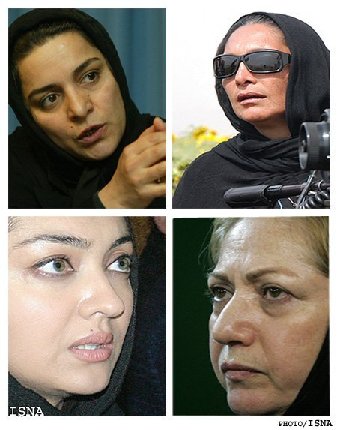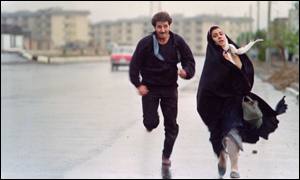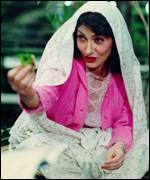Iranian Women Filmmakers (2002)
While film-making in Iran remains a sensitive and intensely political process, women film-makers have produced an impressive body of work in recent years and won a series of international film awards. -- BBC News
(Documentary -- Iran-U.K.)
An One-Off production with support from the Iran Heritage Foundation in London.
With: Laura Mulvey, Sheila Whitaker, Rose Issa, Rakhshan Bani-Etemad, Tahmineh Milani, Shirin Neshat, Fatemeh Motamed-Aria, Niki Karimi, Samira Makhmalbaf:

Produced, directed by: Hamid Khairoldin, Majid Khabazan.
Camera: (color, DV), Khairoldin;
editor: Hassan Hamali Nick;
music: Majid Entezami.
Reviewed on videocassette at Montreal World Film Festival, Aug. 30, 2003.
Running time: 58 MIN.
(English, Farsi dialogue)
* * * * *
Iranian women tell their own story

Iranian film Nargess
Nargess, by 'elder stateswoman' Rakhshan Bani Etemad
The importance of women in Iran's renascent film industry surprises many who believe that Islamic strictures in the country have suppressed female self-expression.
The season of Iranian women's films which starts at London's Barbican on Friday should open minds, writes BBC News Online's Alex Webb.
While film-making in Iran remains a sensitive and intensely political process, women film-makers have produced an impressive body of work in recent years and won a series of international film awards.
In the aftermath of the Islamic revolution in 1979 hundreds of cinemas - seen as channels for Western propaganada - were burnt down.
In the early years of the revolution, huge numbers of films, both Iranian and foreign, were banned and many others heavily censored.
Islamic codes
But in its disapproval of most other leisure activities for the young, the new regime left cinema as the major attraction for young people and helped give it a central role in the country's cultural life.
It was a tribute to the perceived power of the medium that revolutionary guards would attend film shoots to ensure that actors obeyed Islamic codes on and off the screen - sometimes even getting involved in the choice of scenes and camera angles.
The government produced detailed guidelines on how women and relationships could be portrayed on screen which tested the ingenuity of all film-makers.
The Ministry of Culture's 1996 guidelines forbid the showing of any part of a women's body except the face and hands, tight feminine clothes, physical contact between men and women, and foreign or joyous music.
Ferment
Since the revolution there has also been a four-stage film censorship process starting with approval of the script and ending with the granting of a screening permit, though since 1997 there has been some relaxation of the script approval process.
With the rise of a reformist movement in recent years Iran has seen a cultural and political ferment which film-makers have found difficult to represent within the rules.
 |
| Rakhshan Bani Etemad 's Nargess |
At the same time, these restrictions seem to have acted as a spur to a style of clever and symbolic story-telling, which has produced a world-recognised school of cinema.
And women directors have been at the forefront of the latest wave.
Blackboards
One of the best-known female film directors in the country today is Samira Makhmalbaf, who directed her first film The Apple at 17 years old.
The daughter of the prolific film maker Mohsen Makhmalbaf, Samira Makhmalbaf won the 2000 Cannes Jury Prize for her following film Blackboards, about the trials of two travelling teachers in Kurdistan.
Mohsen's wife Marzieh Meshkini also makes films and her The Day I Became A Woman won a prize at the Toronto Film Festival.
Rakhshan Bani Etemad has established herself as the elder stateswoman of Iranian cinema with documentaries and films dealing with poverty, crime, divorce and polygamy such as Nargess and Lady In May.
Jafar Pahani's The Circle, a hard-hitting film about women prisoners, is possibly the boldest film to have come out of Iran since the revolution.
It signals a move away from poetic symbolism and metaphors and towards a more direct style of story-telling, and won the Golden Lion award in Venice in 2000.
Women film-makers have already performed the considerable feat of putting Iranian cinema on the world map while trying to portray women's relationship with Iran and its Islamic revolution.
Presidential elections
But, despite these successes, the environment for women film-makers in Iran remains turbulent, as the political fortunes of the conservatives and reformers continue to ebb and flow.
The result of the presidential elections on 8 June will have a major influence on the climate of the country's intellectual and artistic life.
For film-makers the stakes, as ever, will be high.
As recently as September 2000, an Iranian cinema in Ahwaz was damaged by fire for screening Bride Of Fire, a film about the portrayal of marriage rituals in the Arab south of the country. -- BBC News
|

